In 2023, at least 3,275 people were killed in traffic crashes due to distracted driving, a figure that represents 8% of all traffic fatalities, according to data from the National Highway Traffic Safety Administration. An additional 633 fatalities involved driver drowsiness.
Attention support technologies, designed to help drivers stay alert and focused behind the wheel, can theoretically help curb some of these accidents. If the technology detects signs of distraction or fatigue, it activates audible or visual alerts to reengage the driver’s attention.
But for these features to work, drivers must turn them on — and they frequently turn them off.
According to new research from the Insurance Institute for Highway Safety, however, Subaru drivers have widely accepted and used Subaru’s DriverFocus, a driver-monitoring system that uses a camera to detect possible distraction and drowsiness in a driver. In an online survey, 87% of U.S. Subaru owners reported always using or mostly using DriverFocus while operating their cars. In addition, 70% of Subaru owners said they would want the technology in their next cars, with 64% of drivers who use DriverFocus saying it makes them safer drivers.
“Such a high level of acceptance for a system designed to keep drivers’ attention on the road is a bit surprising and very encouraging,” David Harkey, IIHS president, said in a statement.
Research from the AAA Foundation for Traffic Safety has found that “annoyance” is a key reason why drivers turn off different advanced driver-assistance systems. While the IIHS study found only 4% of Subaru drivers reported turning off DriverFocus, those who did so cited annoyance and receiving too many alerts as their top reasons. In its previous research on lane departure warning systems, IIHS found that drivers may find haptic alerts (like steering wheel vibrations) less annoying than audible alerts.
Many automakers offer attention support features like DriverFocus as part of a suite of advanced driver-assistance systems in their vehicles. Camera-based attention support systems often work in conjunction with partial automation systems to minimize the risk of overly relying on automation features, but DriverFocus operates independently of these features. It is the first driver-facing, camera-based monitoring system designed to do so.
Because most drivers don’t use automation features, “updating the software of [other] vehicles to give drivers the option to use driver monitoring outside of partial automation would increase its potential to reduce preventable crashes and injuries,” the IIHS report said.
IIHS surveyed 3,475 U.S. owners of Subaru vehicles with DriverFocus to compile the report. The automaker introduced DriverFocus in 2019 on its Forester vehicle. In addition to the Forester, the technology is currently available on trim-specific Legacy, Crosstrek, Outback and Ascent models.












